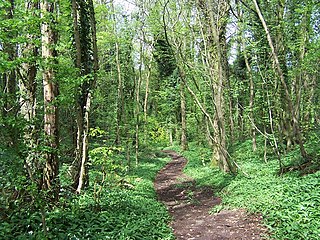Littledean Hall is a country house in the village of Littledean, Gloucestershire, England. It is has been described as one of the most haunted houses in England and is thought to be the oldest house in the United Kingdom which is still occupied. Saxon and Celtic remains have been uncovered in the cellars. Part of the house is designated an SSSI as it is a proven breeding roost for the Greater Horseshoe Bat (Rhinolophus ferrumequinum).

Chilmark Quarries is a 9.65 hectare biological and geological Site of Special Scientific Interest (SSSI), in the ravine south of the village of Chilmark in Wiltshire, England.
Fonthill Grottoes is a 0.69 hectare biological Site of Special Scientific Interest, in woodland adjacent to Fonthill Lake in Wiltshire, notified in 1994. Its SSSI designation is due to its roosting bats: the site is the sixth largest hibernaculum in Britain.

Box Mine is a 56.6 ha biological Site of Special Scientific Interest, near the village of Box in Wiltshire, England, notified in 1991.

Old Iron Works, Mells is a 0.25 hectare biological Site of Special Scientific Interest, in the Wadbury Valley, south of the village of Mells in Somerset, notified in 1987. The site is a ruined iron works, which mainly produced agricultural edge-tools that were exported all over the world, and is now, in addition to its unique and major importance in relation to industrial archaeology, used as a breeding site by horseshoe bats. The block of buildings adjacent to the entrance is listed Grade II* and most of the rest of the site is a Scheduled Ancient Monument. It is included in the Heritage at Risk Register produced by English Heritage.
Winsley Mines is a 1.48 hectare biological Site of Special Scientific Interest, near the village of Winsley in Wiltshire, England, notified in 1989.

Sylvan House Barn is a 0.005-hectare (0.012-acre) stone built barn near the village of St Briavels, in the Forest of Dean, Gloucestershire. Because of its breeding bats, the site was notified as a biological Site of Special Scientific Interest in 1995.

Swanpool Wood and Furnace Grove is a 13.59-hectare (33.6-acre) biological Site of Special Scientific Interest, in Gloucestershire in South West England. The site is listed in the 'Forest of Dean Local Plan Review' as a Key Wildlife Site (KWS).

Lady Park Wood National Nature Reserve is a 45-hectare (110-acre) nature reserve straddling the borders of Gloucestershire in England and Monmouthshire in Wales. Most of the wood is in Wales – where it forms Wales' easternmost point – but it is managed under agreement with Natural England.

Upper Wye Gorge is a Site of Special Scientific Interest (SSSI), noted for its biological and geological characteristics, around Symonds Yat in the Wye Valley on the Wales–England border. The site is listed in the 'Forest of Dean Local Plan Review' as a Key Wildlife Site (KWS).

Blaisdon Hall is a Grade II* listed building at Blaisdon. It includes a 0.07-hectare (0.17-acre) biological Site of Special Scientific Interest in Gloucestershire, notified in 1995.

Caerwood And Ashberry Goose House is a 0.01-hectare (0.025-acre) biological Site of Special Scientific Interest in Gloucestershire, England, notified in 1991. The site was previously notified as Caerwood, Tidenham and lies within the Wye Valley Area of Outstanding Natural Beauty.

Devil's Chapel Scowles is a 44.79-hectare (110.7-acre) biological Site of Special Scientific Interest in Gloucestershire, notified England, in 1998. The site lies in the Forest of Dean and has four units of assessment by Natural England.

Highbury Wood is a 50.74-hectare (125.4-acre) biological Site of Special Scientific Interest in Gloucestershire, notified in 1983.

Old Bow And Old Ham Mines is a 40.3-hectare (100-acre) biological Site of Special Scientific Interest in Gloucestershire, notified in 1998.

Shorn Cliff And Caswell Woods is a 69.2-hectare (171-acre) biological Site of Special Scientific Interest in Gloucestershire, notified in 1986. The site is listed in the 'Forest of Dean Local Plan Review' as a Key Wildlife Site (KWS).

The Hudnalls is a 94.4-hectare (233-acre) biological Site of Special Scientific Interest in Gloucestershire, notified in 1972. The site is listed in the 'Forest of Dean Local Plan Review' as a Key Wildlife Site (KWS).

Westbury Brook Ironstone Mine is a 15.69-hectare (38.8-acre) biological Site of Special Scientific Interest in Gloucestershire, notified in 1998.

Wigpool Ironstone Mine is a 34.88-hectare (86.2-acre) biological Site of Special Scientific Interest in Gloucestershire, notified in 1998.














